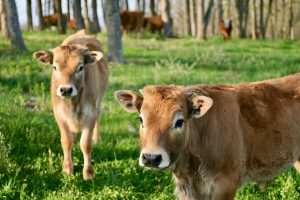 While driving past grazing cattle along a country road, you may quickly glance and appreciate the beauty of happy cows on green pastures. What you might not realize, is that soil science and animal husbandry is required to make this picturesque moment. We’re going to share our process for managing cool season perennial grasses and rotational grazing methods. Next time, as you pass that wonderful scene, you’ll have a better understanding on the work involved behind the view.
While driving past grazing cattle along a country road, you may quickly glance and appreciate the beauty of happy cows on green pastures. What you might not realize, is that soil science and animal husbandry is required to make this picturesque moment. We’re going to share our process for managing cool season perennial grasses and rotational grazing methods. Next time, as you pass that wonderful scene, you’ll have a better understanding on the work involved behind the view.
During spring, our pastures are brilliant green, lush and full of energy and nutrients from clovers, orchard grass, brome and fescues. This is a perfect beginning for rotational grazing.
Our cattle diets are carefully monitored for optimal health. We prefer to pulse graze our herd; allowing them only brief periods of grazing several times a day. Cattle have a tendency to bloat with an over abundance of rich feed and this can be deadly. In between our grazing periods, we provide dry grass hay. This helps temper their rumen to avoid the dreadful bloat. There’s also a limited take-up of magnesium with the quick growing grasses. This can cause grass tetany, a metabolic disease involving magnesium deficiency. Another reason why short visits on the pastures are beneficial for cows during the spring season.
Short grazing periods and frequent moves to different pasture sections allow cattle to take the best of the best. It also gives the grass 15 to 21 days for regrowth. We want to reduce hindrance of root growth when pastures are in fast growth mode. We find it’s best to move cows over to new grass so they don’t take the 2nd or 3rd bite from the pasture while grazing. Grass regrowth typically begins 2 to 4 days after grazing during the early season. Lingering grazing might injure this regrowth that is vital for grass health.
Many people, out of necessity or desire, use a type of grazing called continual grazing. This involves giving the animals access to the entire pasture. What often happens is that the animals re-graze their preferred areas. This can lead to overgrazing and depleted root recovery.
During dryer periods later in the summer, we leave our cattle on paddocks longer because grass grows very slow during hot dry periods. During this time, we allow our grasses to grow longer before grazing is allowed. Many refer to this method as tall grass grazing. Another benefit to mature, tall grass is that it slightly tempers the richness and our animals get a better balance with dry matter.
We have a smorgasbord of mixed grasses in our pastures and sections we make into hay. Our mixture includes several clovers in limited amounts. We like milvus red, alsike white, ladino and alice white, as well as several grazing alfalfas. The other 80% generally contains cool seasonal perennial grasses such as orchard grasses of varying maturing periods, meadow brome, endophyte free tall fescue, maybe some timothy and occasionally reed canary grass in wetter areas. We’ve had success with our grass blends.
Our soil pH is checked annually. Our goal is to keep the soil at 6.8 to 7.1 ranges.
Intensive rotational grazing has proven to keep our soil type healthy. For nitrogen purposes, we lightly spread dry organic turkey manure/litter spread in late winter prior to the spring flush. We choose not to use pesticides or herbicides. Any excessive patches of obnoxious weed growth, like thistle, are stomped to the ground when cattle are grazed tightly in these areas. Actually, this weed stomping process also enriches the carbon in our soil and helps to control future weed growth.
Hopefully, you’ve found some helpful techniques or gained a better understanding on rotational grazing. As many farmers, we love to share and exchange information.